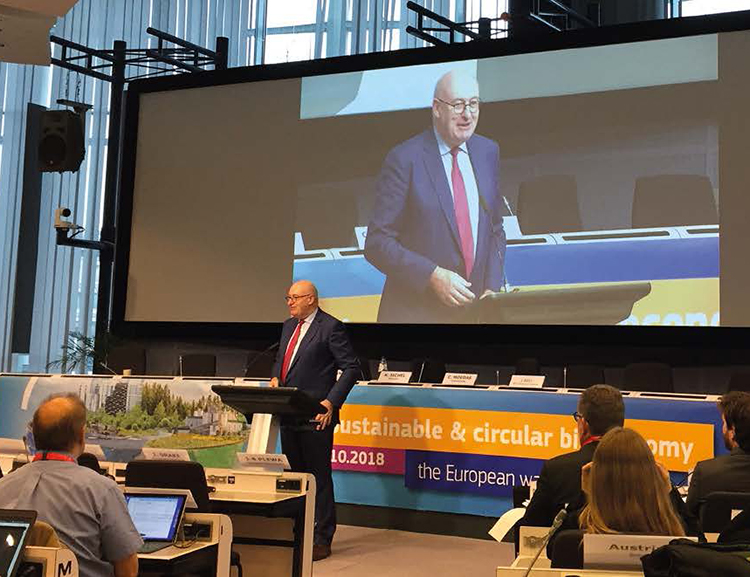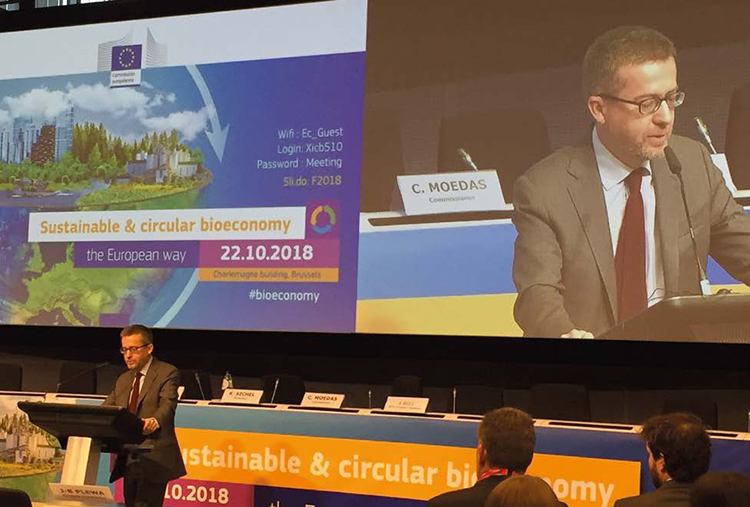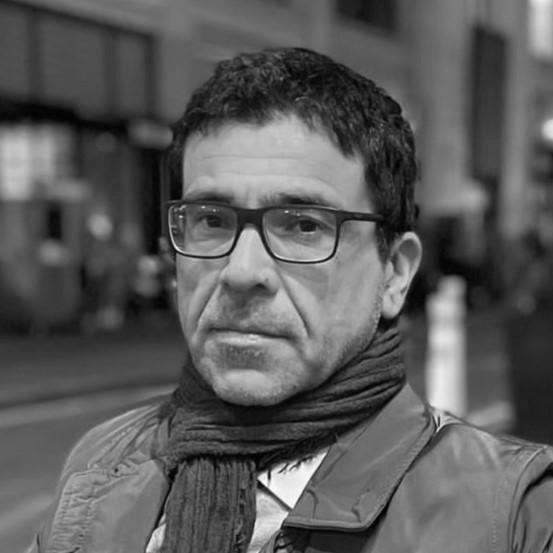 |
|
Phil Hogan
|
 |
|
Carlos Moedas
|
“A turning point, a milestone.” This is how Carlos Moedas and Phil Hogan – respectively European Commissioner for Research, Science and Innovation, and Commissioner for Agriculture and Rural Development – defined the updated European bioeconomy strategy, A sustainable Bioeconomy for Europe: Strengthening the connection between economy, society and the environment.
Published on 11th October and officially presented in Brussels on the 22nd during an event that gathered around 600 people in the capital, the update comes six and a half years after the first strategy. Even the very title spells out the direction taken by parties at the Berlaymont building: the bioeconomy must be sustainable and circular.
“A sustainable bioeconomy – reads the new strategy – is a renewable segment of the circular economy. It can convert bio-waste, residues and discarded materials into valuable resources, it can create innovation and incentives that are able to help retailers and consumers cut up to 50% of food waste by 2030. It has been estimated that the soil – currently used to produce animal feed – that could be protected by these innovations could feed an additional three billion people. Cities should become the main centres of the circular bioeconomy. Circular urban development plans could lead to extremely significant economic and environmental benefits.”
There is more: it is also clear that agriculture could go beyond its simple role of raw material provider by becoming the real protagonist in the decarbonisation process that, according to Hogan’s statement, with the new strategy, could not only help achieve greenhouse gass emission reduction objectives but above all create up to one million jobs by 2030 with important benefits for rural areas.
We are talking, to cite Carlos Moedas again, “about the next step in the industrial evolution.” “We cannot carry on consuming in the same linear way without consequences,” highlights the Portuguese Commissioner. “Somehow, we must maintain the same quality of life while protecting our planet. The bioeconomy is the way to achieve this objective.”
The aim of the strategy update – following the revision published in November 2017, which in itself was a summary of the reflections emerged from the Bioeconomy Stakeholders Conference held in Utrecht in April 2016 – is to tackle global challenges such as climate change as well as soil and ecosystem degradation through fourteen concrete actions to be launched in 2019 at the latest.
The Strategy
Europe has come a long way since the European Commission presented its first bioeconomy strategy Innovating for Sustainable Growth: A Bioeconomy for Europe, in February 2012.
“Europe must move to a ‘post-oil’ economy. A greater use of renewable resources is no longer just a choice but a necessity. We must promote the move to a bio-based rather than a fossil-based society, using research and innovation as driving forces. This is a positive move for the environment, for food and energy security and the future competitiveness of Europe,” stated Máire Geoghegan-Quinn, Commissioner for Research, Innovation and Science in the Barroso Commission.
Over the last six and a half years, there has been COP21 in Paris, Agenda 2030 (UN Sustainable Development Goals) indicating 17 sustainable development goals, and the EU Circular Economy Package. It is only natural that the strategy needs updating, above all to further integrate it with the circular economy and sustainable development principles, which are not always applied in some bioeconomy cases.
“Our planet’s limited resources and biological ecosystems,” concludes the EC communication updating the strategy, “are essential to feed people, to provide clean water as well as clean and accessible energy. A sustainable bioeconomy is essential to tackle climate change and soil and ecosystem degradation. It will deal with the increasing demand for food, feed, energy, materials and products caused by the world population growth and it will reduce our dependence on non-renewable resources. Implementing a sustainable and circular bioeconomy will increase the competitiveness of bioeconomy sectors and will support the creation of value chains all over Europe while improving the overall status of our natural resources. Such a bioeconomy will be mainly based – and capitalise – on renewable resources available at national level and on scientific and technological advances and innovations combining the physical, digital and biological worlds in some of the EU’s most important sectors and industries.”
Just a few months away from the European elections, the trail is already blazed. However, in order to tackle the global challenges for sustainable economic and social development we will need an increasingly united and cohesive Europe. A condition that in the current political context does not seem easily achievable.
To this end, an action invoked by many during the conference on 22nd October concerns communication. For some time now, in Brussels, they have understood that to decarbonise we need to have citizens (alias consumers) and big businesses on our side. “The bioeconomy is the food we eat, the clothes we wear, the products we use. Show European citizens that the bioeconomy creates value,” Moedas urged attending businesses.
“If we don’t shout what the bioeconomy can do, then its potential will stay the same. The future success of our strategy depends on how we show citizens that the bioeconomy is the way of creating solutions,” carried on Moedas.
However, the Commissioner did not witness the launch of the plastic bottle by Sveinn Margeirsson, CEO of Icelandic research company Matís and speaker in the session devoted to local development of the bioeconomy. During his speech Margeirsson even reprimanded the Commission for its lack of consistency, whereby in a conference devoted to the circular bioeconomy water was still being offered in fossil-fuel derived bottles.
Communication aside, the strategy identified three main areas of action: strengthening and enhancing bio-based sectors, unlocking investments and markets; rapid development of the bioeconomy at local level all over Europe; and understanding its ecological limits.
“The communication of this update is timely, given the recent urgent call to action by the Intergovernmental Panel on Climate Change (IPCC). In particular, we would like to welcome the focus on scalability of bio-based sectors through the support for innovation and the unlocking of investments and markets, and on the spreading of the bioeconomy throughout the whole of Europe,” stated BIC, Bio-Based Industries Consortium, the driving force behind the public-private partnership Bio-based Industries Joint Undertaking (BBI JU).
It is no coincidence that the topic of investment and support for the growth of new businesses is another pillar of the new strategy. “Moving from pilot scale to the demonstration one is still very hard in Europe. We want to close this gap,” states Andrew McDowell, Vice-President of the European Investment Bank (EIB). Mathieu Flamini also expressed his opinion along these lines: the former Arsenal and AC Milan football player, co-founder of the biochemical company GFBiochemicals, asked for better support by investors for bioeconomy start-ups and youth entrepreneurship.
In this perspective, the Commission launched an investment platform for the circular bioeconomy that will put on the table €100 million. “The selection of a fund manager is on,” said John Bell, Director for the Bioeconomy in Research & Innovation, European Commission.
However, the big business crux still remains. Jos Peeters, partner of the Belgian fund Capricorn Venture, highlights how “relations with big companies are not simple.” This is demonstrated, according to Peeters, by BASF’s decision to abandon the joint venture Synvina created with Avantium to develop new PEF (polyethylene furanoate) based bioplastics.
“We need more integrated projects in local areas, ambitious targets and more success stories,” pointed out Catia Bastioli, Novamont CEO.
The message coming from Brussels is that the path towards the circular bioeconomy is a one-way road if we really want to reconnect the economy, society and the environment. Undoubtedly, it will not be simple since there is no shortage of obstacles and opponents, but Tiago Pitta e Cunha, CEO of Oceano Azul Foundation, has no doubts: “decarbonisation will be the key to the 21st century.”
European Commission, A sustainable Bioeconomy for Europe: Strengthening the connection between economy, society and the environment, October 2018; https://ec.europa.eu/research/bioeconomy/pdf/ec_bioeconomy_strategy_2018.pdf#view=%20fit&pagemode=%20none



